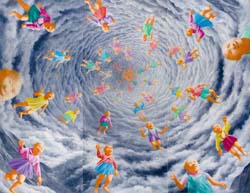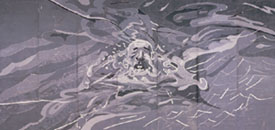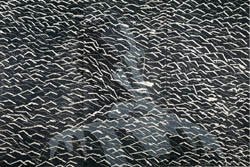


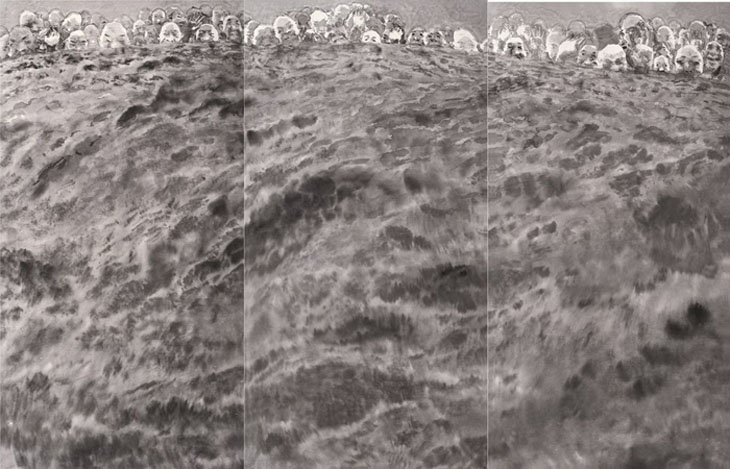


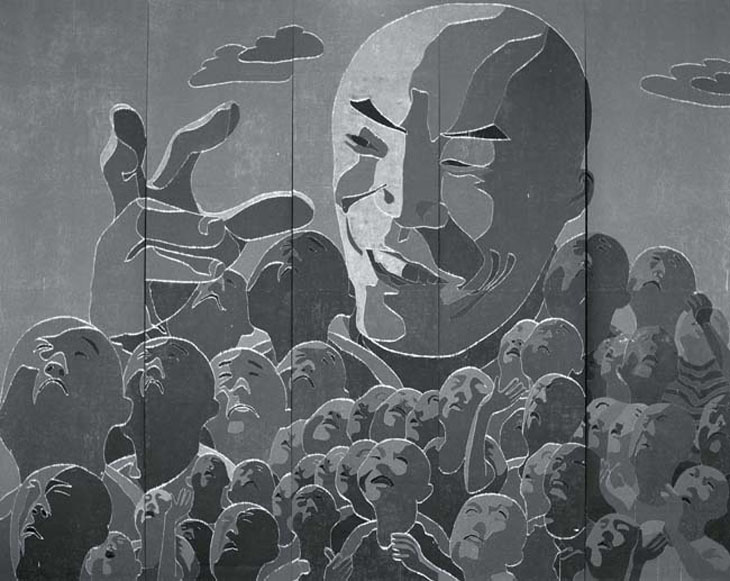
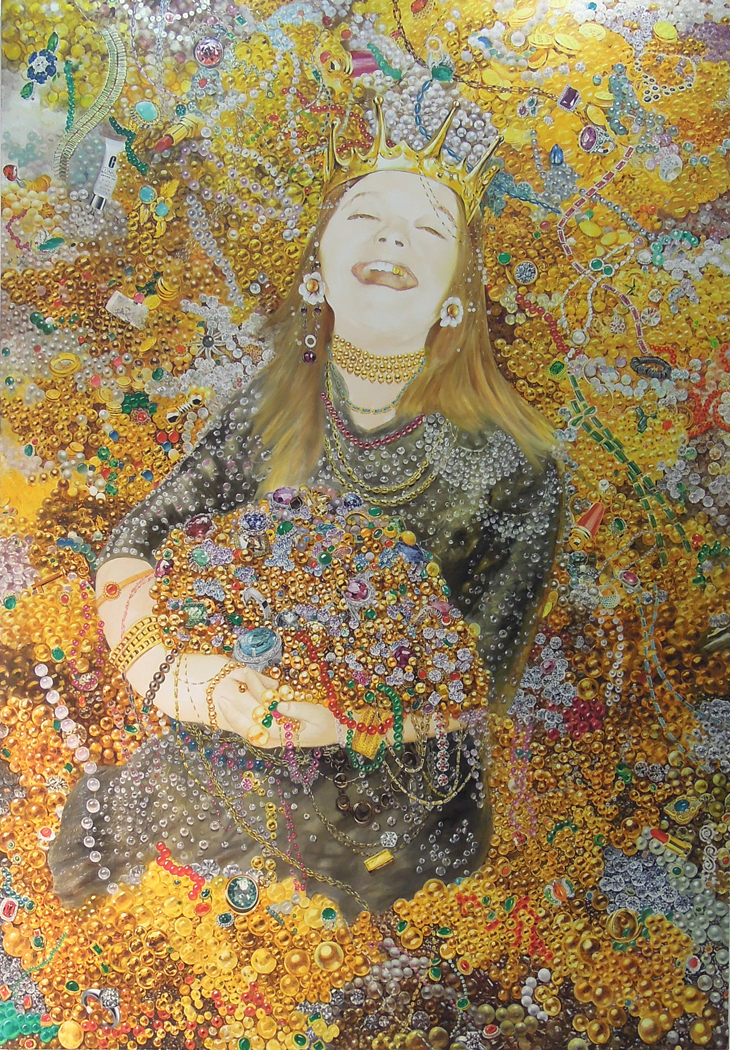
ARTIST:
Fang Lijun
One of the leading proponents of the early 1990s Cynical Realist movement, Fang Lijun’s work encapsulates the disillusionment of China’s youth; a generation defined by the events at Tiananmen Square and China’s internal domestic policies. Constructed around loose narratives Fang’s images personalise sentiments of disenchantment, angst, and rebellion; his fictional suggestions conveyed through his illustrative style and re-occurring bald-headed protagonist.
Fang’s practice exhibits a rarefied technical skill rigorously studied through his Social Realist training; his combination of this aesthetic with references to contemporary comics, folk art, and dynastic painting characterise a national identity in flux, distilling a position of integrity from tradition and the modern world.
Fang’s monumental sized prints revive the ancient Asian practice of woodblock printing -- a complicated and exacting process of carving a ‘negative’ image into a panel, coating the surface in ink, and impressing the image onto paper; each different colour and tone requires a separate plate and order of printing. Due to their immense scale, Fang’s images are composed on several adjoined scrolls; the elongated strips create both an emotive fragmenting of the image, and create a reference to memory and historical testimony. Thematically, each of these prints describe the plight of the individual against the ‘mass’, creating a spiritual contemplation of solitude the quest for personal probity in the face of adversity.
Fang’s painting 30th Mary evokes these same sentiments with a humorous effect. Reminiscent of European church ceiling paintings, Fang portrays an order of ascendancy of same-same kewpie figures, each based on his own image. Executed with painstaking hyper-realism, the clouds formulate as a tempestuous funnel rather than a portal of billowing promise. Contrasted with the kitsch palette and pop rendering of the grotesque cherubs, Fang’s painting approaches the sanctity of ideological assurance with an empathetic cynicism. One of the leading proponents of the early 1990s Cynical Realist movement, Fang Lijun’s work encapsulates the disillusionment of China’s youth; a generation defined by the events at Tiananmen Square and China’s internal domestic policies. Constructed around loose narratives Fang’s images personalise sentiments of disenchantment, angst, and rebellion; his fictional suggestions conveyed through his illustrative style and re-occurring bald-headed protagonist.
Fang’s practice exhibits a rarefied technical skill rigorously studied through his Social Realist training; his combination of this aesthetic with references to contemporary comics, folk art, and dynastic painting characterise a national identity in flux, distilling a position of integrity from tradition and the modern world.
Fang’s monumental sized prints revive the ancient Asian practice of woodblock printing -- a complicated and exacting process of carving a ‘negative’ image into a panel, coating the surface in ink, and impressing the image onto paper; each different colour and tone requires a separate plate and order of printing. Due to their immense scale, Fang’s images are composed on several adjoined scrolls; the elongated strips create both an emotive fragmenting of the image, and create a reference to memory and historical testimony. Thematically, each of these prints describe the plight of the individual against the ‘mass’, creating a spiritual contemplation of solitude the quest for personal probity in the face of adversity.
Fang’s painting 30th Mary evokes these same sentiments with a humorous effect. Reminiscent of European church ceiling paintings, Fang portrays an order of ascendancy of same-same kewpie figures, each based on his own image. Executed with painstaking hyper-realism, the clouds formulate as a tempestuous funnel rather than a portal of billowing promise. Contrasted with the kitsch palette and pop rendering of the grotesque cherubs, Fang’s painting approaches the sanctity of ideological assurance with an empathetic cynicism.
Fang’s practice exhibits a rarefied technical skill rigorously studied through his Social Realist training; his combination of this aesthetic with references to contemporary comics, folk art, and dynastic painting characterise a national identity in flux, distilling a position of integrity from tradition and the modern world.
Fang’s monumental sized prints revive the ancient Asian practice of woodblock printing -- a complicated and exacting process of carving a ‘negative’ image into a panel, coating the surface in ink, and impressing the image onto paper; each different colour and tone requires a separate plate and order of printing. Due to their immense scale, Fang’s images are composed on several adjoined scrolls; the elongated strips create both an emotive fragmenting of the image, and create a reference to memory and historical testimony. Thematically, each of these prints describe the plight of the individual against the ‘mass’, creating a spiritual contemplation of solitude the quest for personal probity in the face of adversity.
Fang’s painting 30th Mary evokes these same sentiments with a humorous effect. Reminiscent of European church ceiling paintings, Fang portrays an order of ascendancy of same-same kewpie figures, each based on his own image. Executed with painstaking hyper-realism, the clouds formulate as a tempestuous funnel rather than a portal of billowing promise. Contrasted with the kitsch palette and pop rendering of the grotesque cherubs, Fang’s painting approaches the sanctity of ideological assurance with an empathetic cynicism. One of the leading proponents of the early 1990s Cynical Realist movement, Fang Lijun’s work encapsulates the disillusionment of China’s youth; a generation defined by the events at Tiananmen Square and China’s internal domestic policies. Constructed around loose narratives Fang’s images personalise sentiments of disenchantment, angst, and rebellion; his fictional suggestions conveyed through his illustrative style and re-occurring bald-headed protagonist.
Fang’s practice exhibits a rarefied technical skill rigorously studied through his Social Realist training; his combination of this aesthetic with references to contemporary comics, folk art, and dynastic painting characterise a national identity in flux, distilling a position of integrity from tradition and the modern world.
Fang’s monumental sized prints revive the ancient Asian practice of woodblock printing -- a complicated and exacting process of carving a ‘negative’ image into a panel, coating the surface in ink, and impressing the image onto paper; each different colour and tone requires a separate plate and order of printing. Due to their immense scale, Fang’s images are composed on several adjoined scrolls; the elongated strips create both an emotive fragmenting of the image, and create a reference to memory and historical testimony. Thematically, each of these prints describe the plight of the individual against the ‘mass’, creating a spiritual contemplation of solitude the quest for personal probity in the face of adversity.
Fang’s painting 30th Mary evokes these same sentiments with a humorous effect. Reminiscent of European church ceiling paintings, Fang portrays an order of ascendancy of same-same kewpie figures, each based on his own image. Executed with painstaking hyper-realism, the clouds formulate as a tempestuous funnel rather than a portal of billowing promise. Contrasted with the kitsch palette and pop rendering of the grotesque cherubs, Fang’s painting approaches the sanctity of ideological assurance with an empathetic cynicism.
